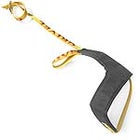I generally prefer leashed, although as an ice climber it’s also true that I’m something of a schlub, so perhaps my preference is immaterial. As a general rule, leashing an ice tool provides an added margin of security (your hand slips from tool, leash catches it). And, more importantly, it greatly reduces fatigue by allowing you to “hang” on the tool, rather than having to grip it constantly.
 The Easy G
The Easy G
On the downside, a leash can limit your arm movement when a tool is placed. And that can make it more difficult to reach your harness loop to grab an ice screw or something. I suppose that mixed-terrain climbers might prefer going leashless when they holster and unholster the tool while making the transition from rock to ice and vice versa.
Still, I’d certainly say that leashed is better聴particularly for those who are not really high-end ice climbers. As for retrofitting a “leashless” tool, well, I’m not sure ANY ice tool is specifically designed to be “leashless.” Every one I’m familiar with has an eye in the head for threading a leash. So I suppose that makes my answer, “Yes, by all means install a leash.”
As for what kind of leash, there’s not all that much between the different products. Grivel’s Easy G Leash ($24; www.grivel.com) is perfectly fine. Interestingly, a few companies are toying with leashes that can be quickly detached if needed. Black Diamond’s Viper ($229; www.bdel.com) can be used with a special leash that bolts to the tool and that has a quick-release feature. Great for those times when you really want a leash but also want a little extra arm freedom.


